Saving butterflies, moths and our environment
Celebrating our 40th Anniversary!
1982 - 2022
Red Admiral on Gosport Garden Parade. A single Red Admiral in all its glory simply gorged itself today on the Eggs and Ham plant alternating with the nearby dwarf Budlea. Wonderful tonic. [Posted by Francis Plowman]
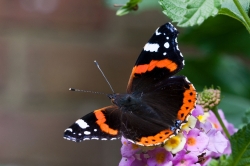 | 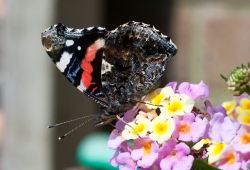 | 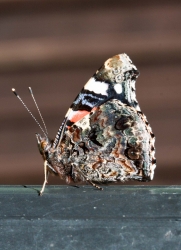 |
| Photo © Francis Plowman | Photo © Francis Plowman | Having a break on the washing line! Photo © Francis Plowman |
Old Winchester Hill NNR. In very warm weather today, the car-park slope was alive with butterflies, mainly Meadow Browns, with good counts of Chalk Hill Blue still with the odd male still looking in reasonable condition. But today belonged to the Adonis Blue, where the males were very active feeding on Eye-bright, and Birds Foot Tre-foil. I counted upwards of (40) with several females also in the mix. The short turf nibbled away by the Herdwick sheep has done a splendid job, not just for the Adonis Blue but the Silver-Spotted Skipper seems to be enjoying their season, with many being see again today (25), with the other slope (main south facing slope) last week makes a good total of nearly (40). Other species of note was one Clouded Yellow, Small Heath (30) Brown Argus (4) Small Blue (1) and many of the other species. [Posted by Ashley Whitlock]
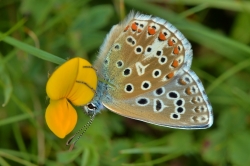 | 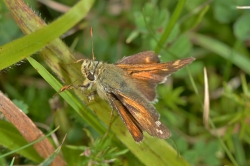 | 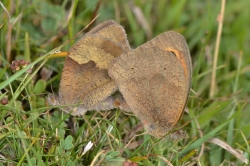 |
| Adonis Blue on Eggs and Bacon! Photo © Ashley Whitlock | Silver-Spotted Skipper didn't rest for long! Photo © Ashley Whitlock | Meadow Brown very good numbers out on the downland Photo © Ashley Whitlock |
Gosport Garden Visitors. How pleasant to relax in our garden and enjoy the few butterflies that are showing interest in our flowers! The first Green-veined White seen in our small garden gives me some modest cause to celebrate. [Posted by Francis Plowman]
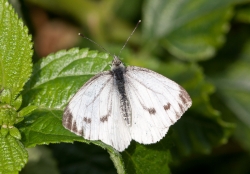 | 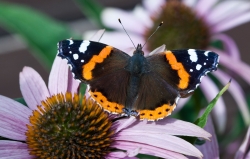 | 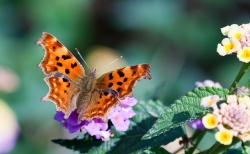 |
| Green-veined White female (28th Aug) Photo © Francis Plowman | Red Admiral on Echinacea (28th Aug) Photo © Francis Plowman | Comma on Lantana Camara (26th Aug) Photo © Francis Plowman |
Chalton Down, Old Idsworth. After visiting Old Winchester Hill, I paid a HBlue numbers have dwindled down almost to single figures here now, with those seen looking very faded and worn along with the Meadow Browns. Only 6 different species were recorded.
Totals: Large White 1, Small White 4, Chalk Hill Blue 10M, Common Blue 9M, Meadow Brown 15, Small Heath 6. [Posted by Roy Symonds]
Old Winchester Hill. Today I visited Old Winchester Hill completing a circular walk covering the main paths. The temperature was 23.5 degrees. Large Whites, Meadow Browns and Common Blues were flying in double figure numbers. Strangely I only counted just a single male Chalk Hill Blue. I recorded two Silver-spotted Skippers but numbers of Adonis Blue were better with 10 males found below the car park slope, along with a single Clouded Yellow. A single female Adonis Blue seen on the far side of the hill fort. A total of 14 different species were seen.
Totals: Brimstone 1M 1F, Large White 11, Small White 6, Clouded Yellow 1, Adonis Blue 10M 1F, Chalk Hill Blue 1M, Common Blue 12M, Small Copper 3, Meadow Brown 62, Small Heath 3, Speckled Wood 1, Red Admiral 1, Small Tortoiseshell 1, Silver-spotted Skipper 2. [Posted by Roy Symonds]
Longstock buddleja census. With most of the buddlejas enjoying their second wind, a brief mid-afternoon census revealed the following: Red Admiral (9), Small Tortoiseshell (4), Brimstone (1), Meadow Brown (2). A Comma was seen on the Verbena bonariensis, but the highlight was an immaculate Small Tortoiseshell nectaring on the dahlia 'Bishop of Llandaff' in the walled garden. [Posted by Andrew Brookes]
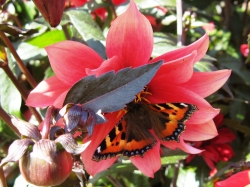 |
| Dahlia delight Photo © Andrew Brookes |
This Year In Our Chandlers Ford Garden SU434199. Well, it’s been a good year in the butterfly garden. Speckled Woods have increased in number, Gatekeepers and Meadow Browns are still here and a new species appeared in July when we found a couple of Ringlets in the garden! Holly Blues have had another good year and we have had a few Commas and Red Admirals. Small Tortoiseshells are present but in small numbers and I haven’t seen a Peacock in the garden since late spring. Large Whites and Small Whites are in good numbers at the moment and a Green-veined White turned up today on the Buddleia. Also today, after lamenting the lack of Small Coppers in my OWH report, we had one turn up on the Rudbeckia! It was a beautiful fresh example and the first one I’ve seen in the garden for 3 years! Yesterday the first Painted Lady in the garden turned up. A lovely fresh female with deep orange colouring. This was closely followed by a Hummingbird hawk moth. We have had a few sightings of these already this year.
It was fun to watch two Speckled Woods spinning round and round each other and then one pinned the other to the ground which I managed to grab a quick shot of.
The newly planted nettle bed is growing nicely now and the wild flower bed has done well this year. It was good to see a female Speckled Wood laying eggs in the long grass today and I notice we have quite a bit of Sorrel in the garden that may account for the Small Copper. Hopefully when the new nettle bed is established next year, we may see more Small Tortoiseshells, Commas, Peacocks and Red Admirals using it. [Posted by Tracy Piper]
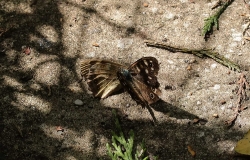 | 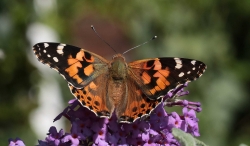 | 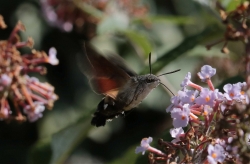 |
| Speckled Woods in a wrestling match Photo © Tracy Piper | Painted Lady female Photo © Tracy Piper | Humming-bird Hawk-moth Photo © Tracy Piper |
This Year In Our Chandlers Ford Garden SU434199 cont.... Some more photos...... [Posted by Tracy Piper]
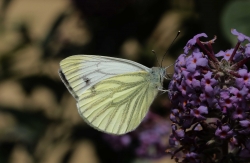 | 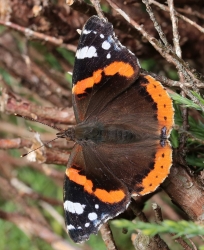 |  |
| Green-veined White Photo © Tracy Piper | Red Admiral female Photo © Tracy Piper | Small Copper....at last! Photo © Tracy Piper |
Old Winchester Hill. We had a fantastic time at Old Winchester Hill today and spent 5 hours (1000-1500) there walking right around the reserve. Species recorded there included Adonis Blue 20,Chalk Hill Blue 24,Silver-spotted Skipper 28,Clouded Yellow 1,Painted Lady 1,Brown Argus 1, Brimstone 8,Red Admiral 2,Peacock 3,Small Tortoiseshell 3,Speckled Wood 5,Comma 2,Small Copper 2. Plus good numbers of Meadow Brown and Common Blue, other species seen but not counted were Small Heath, Large White and Small White. Birds of note included a Red Kite, a Raven and c150 House Martins. (Barry and Margaret Collins) [Posted by Barry Collins]
Noar Hill. Today I visited Noar Hill where the temperature reached 22 degrees. Although I searched high and low, no Brown Hairstreaks were sighted today. Meadow Browns and Common Blues with Small Heaths were the most abundant species flying. A total of 10 different species were recorded.
Totals: Brimstone 1M 5F, Large White 5, Small White 5, Common Blue 11M 5F, Gatekeeper 1, Meadow Brown 22, Small Heath 10, Speckled Wood 7, Red Admiral 2, Small Tortoiseshell 4. [Posted by Roy Symonds]
Old Winchester Hill More Photographs. More photos from the afternoon on Old Winchester Hill
https://awayfromfourmarks.blogspot.co.uk/ [Posted by Chris Rose]
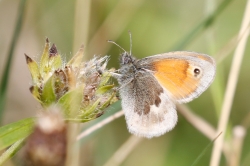 | 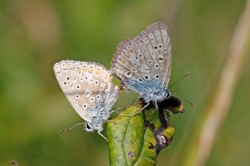 | 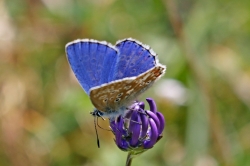 |
| Small Heat Photo © Chris Rose | Chalk Hill Blues Photo © Chris Rose | Adonis Blue Photo © Chris Rose |
Old Winchester Hill. Spent the afternoon at Old Winchester Hill, conditions were perfect and there were plenty of butterflies about on the south slope of the hill forts. Difficult to count but very good numbers of Silver-spotted Skipper, Adonis Blue and Chalkhill Blue, the three target species! The skippers were actively engaged in mating, and egg laying.
Supporting cast came from many Small Heaths, Small Tortoishells and a single Painted Lady.
https://awayfromfourmarks.blogspot.co.uk/ [Posted by Chris Rose]
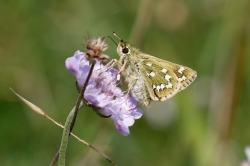 | 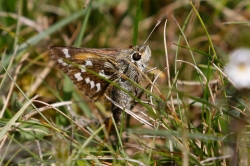 | 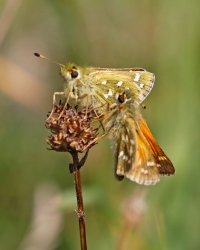 |
| Silver-spotted Skipper Photo © Chris Rose | Silver-spotted Skipper Photo © Chris Rose | Silver-spotted Skipper Photo © Chris Rose |
Noar Hill NNR Field Trip. More photographs from the field trip [Posted by Ashley Whitlock]
Noar Hill NNR Field Trip. Today was a glorious day in more ways than the weather, excellent counts of field trippers coming to hopefully see their quarry the Brown Hairstreak, they were not to be disappointed!Walking along the footpath from Charity Farm entrance we had a glimpse of a female in a maple tree, where she manoeuvred herself to feel the sunshine. I also saw another flitting through the tree tops close by, it looked as if we were in for a treat.We went down to the triangle where there are normally a few females flying about a large Ash tree at the bottom of the area. I saw one flying but there were no others coming down to nectar. We came around to another smaller area, where there were the Rufus Grasshoppers, and here we found a female Brown Hairstreak in excellent condition, extremely tame. I've met some tame butterflies in my butterflying career, but this female took the biscuit. She had the paparazzi around her whilst she posed rather nicely for us, and then she started egg-laying in a small thicket of Blackthorn not much higher than knee high. There were 28 of us and we all had good views of her as she manoeuvred herself around the area, not flying off at all, she was totally at ease with us all. In all we saw upwards of (8) females which is an excellent total. Other species of interest were Brown Argus, Small Heath, and a family of Spotted Flycatchers were flying around a dead Ash tree, along with Red Kite. Id like to thank everybody who came who made this field trip probably the best for the season...so far! [Posted by Ashley Whitlock]
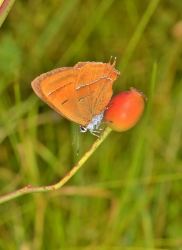 | 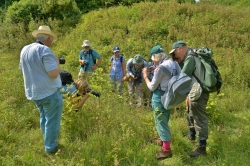 | 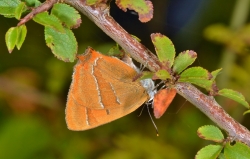 |
| Just a great poser....... Photo © Ashley Whitlock | Totally tame with so many admirers! Photo © Ashley Whitlock | Looking for a good spot to lay an egg on a Blackthorn twig Photo © Ashley Whitlock |
Old Winchester Hill. Day off work so decided to visit OWH to see if I could find the Clouded Yellows that were reported from the bottom of the car park slope. This is one butterfly I have not yet managed to photograph so I was hoping to change that.
On the way to the slope we saw 2 Speckled Woods and I got a lovely underside shot. Wandering down the slope we could see the numbers of Chalk Hill Blue were still good. Although tatty now in most cases the hill was shimmering with them and abundant Meadow Browns. As we neared the bottom of the slope the numbers got better and better. There were a few Small Heaths, Common Blues and right down the bottom, good numbers of Adonis Blues. We also found a couple of Spotted Skippers on the way down and a couple more at the bottom. A solitary Small Copper appeared but Dave only managed a quick blurred shot before it disappeared again. This is one butterfly I am worried about. This is the only one we’ve seen this year, where have they all gone? Plenty of Brimstones were also here and some worn Gatekeepers. In the small field at the very bottom we found 3 Clouded Yellows flying around and watched to see which flowers they stopped at. I then staked out a Ragwort and waited for them to come to me. This finally paid off and I managed to get a couple of acceptable shots. Another one off the list! The male Adonis Blues were more obliging and I got a couple of lovely shots.
On the way back up another Silver Spotted Skipper this time a female, posed for a nice pic. It was a lovely hot day and a very productive 2 and a half hours, from 12.15 – 2.45. The hill was alive with butterflies and the best I’ve seen it for a while. So all in all we saw, on the car park slope, (numbers only where we had an accurate count)2 Speckled Woods, 6 Spotted Skippers, 3 Clouded Yellows, 2 Peacocks, 3 Tortoiseshells, 5 Small Heaths, countless Meadow Browns, Chalkhill Blues, good number of Adonis Blues, a few Common Blues, several Brimstones, Large Whites, Small Whites, Gatekeepers and a Small Copper. Also a quick glimpse of a possible fritillary seen by Dave. [Posted by Tracy Piper]
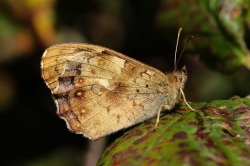 | 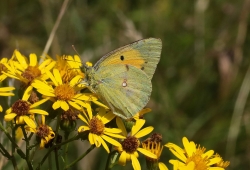 | 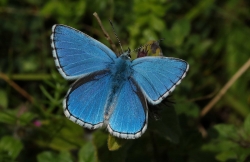 |
| Speckled Wood Photo © Tracy Piper | Clouded Yellow Photo © Tracy Piper | Stunning Adonis Blue Photo © Tracy Piper |
Old Winchester Hill....cont.. ...some more photos [Posted by Tracy Piper]
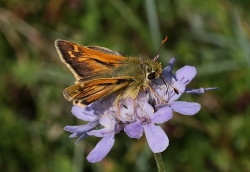 | 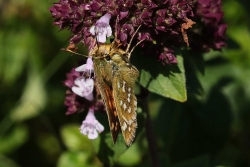 | 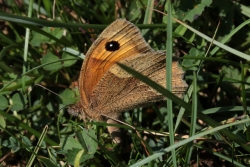 |
| Sliver Spotted Skipper male Photo © Tracy Piper | Silver Spotted Skipper female Photo © Tracy Piper | Meadow Brown laying eggs Photo © Tracy Piper |
Old Winchester Hill - Blue, Yellow and Silver. Today I paid a return visit to Old Winchester Hill (SU6420) in much sunnier conditions, following my disappointment in not finding any Adonis Blue a few days earlier. The temperature was 21 degrees. Numbers of butterflies were much higher with a total of 13 different species recorded. I continued my usual walk to the hill fort and round, down the steps to the bottom of the woods then along the bottom of the car park slope before ascending the slope. Around the hill fort several Chalk Hill Blues were seen, with Meadow Browns in good numbers. On emerging from the woods, walking the path towards the bottom of the car park slope, I saw a few Clouded Yellows. One of which landed on the chalk path directly in front of me allowing a photograph. Along here I saw my only Silver Spotted Skipper. A little further from my close encounter with the Clouded Yellow, I saw the Adonis Blues. A total of 9 males were seen, with one or two landing on or near the path for photo opportunities. A very good day for me, having now seen all the usual species which I expected to see during the course of the year. Although I still have not seen a White-letter Hairstreak despite my searches around Lakeside, Cosham earlier in the summer.
Totals: Brimstone 6M, Large White 2, Small White 3, Clouded Yellow 3, Adonis Blue 9M, Chalk Hill Blue 22M 1F, Common Blue 15M, Gatekeeper 1, Meadow Brown 70, Small Heath 9, Speckled Wood 2, Small Tortoiseshell 1, Silver-spotted Skipper 1. [Posted by Roy Symonds]
Noar Hill NNR. Another very over cast day and the temperature wasn't particularly good for observing my quarry the Brown Hairstreak. I was there up to three hours without a sniff, and happened to sit down on an ant hill eating my lunch in an area renowned for females laying their eggs. I had just espied a butterfly on a bush about Gatekeeper size but I hadn't seen any Gatekeepers today, so I investigated and sure enough it was a lovely female Brown Hairstreak, which flew right by where I was sitting. The weather was improving somewhat and she was warming herself up, and started opening her wings. She remained quite motionless other than opening her wings and then closing them again when the sun went in. She had obviously got enough warmth to fly off after about 10 minutes to start to egg-lay on waist and knee high Blackthorn. She was only egg-laying when the sun came out, and then when it went in again which was quite often, being so overcast, she just rested up. She then flew off after she had layed a few eggs to look for other areas which were suitable. [Posted by Ashley Whitlock]
Sinah and Stoke Commons, Hayling Island. Today I visited two of my local sites where I live on Hayling Island. First to Sinah Common (SZ6999) where the only butterflies seen were Whites. A total of 12 Large Whites and 9 Small Whites were recorded.
Further North at Stoke Common (SU716032) again Whites were the main species flying with 4 Large Whites and 5 Small Whites recorded along with a second generation Holly Blue. [Posted by Roy Symonds]
Old Winchester Hill. Today in cloudy conditions I visited Old Winchester Hill (SU6420). The temperature was 19 degrees, but with sunny spells conditions were not ideal to spot Adonis Blues. After completing a full circuit of the hill fort and along the bottom of the car park slope I could find no Adonis Blues or Silver-spotted Skippers. Many Meadow Browns and Chalk Hill Blues were flying with other common species.
Totals: Brimstone 1F, Large White 3, Small White 2, Chalk Hill Blue 24M 2F, Common Blue 2M 1F, Gatekeeper 3, Meadow Brown 65, Small Heath 2, Speckled Wood 1. [Posted by Roy Symonds]
Old Winchester Hill Delivers Again. We dropped in to Old Winchester Hill on the way back from a rather disappointing couple of transects at Magdalen Hill Down, where the sun failed to come out. We were well rewarded for our efforts on the steep slopes. A couple of immaculate Adonis Blue and a few Silver-spotted Skipper were dancing among the Autumn Gentian and Autumn Lady's-tresses. There were also some remaining Chalk Hill Blue in excellent shape, both in appearance and sexual vigour. Two or three Clouded Yellow were tearing around the valley like kids on BMX bikes, whilst two Small Tortoiseshell stretched out in the last of the evening sun. [Posted by Michael Berry]
Martin Down. It felt like I had the Down to myself this morning with not another soul in sight until gone 1200. Perhaps the locals know something I don't about the weather - the forecast was good but in reality it was very overcast, breezy, hardly any sun and even some rain. That said, my target for the day didn't disappoint - Adonis Blues showed very well (even in the bit of rain). Difficult to give an accurate count as they seem concentrated in one patch of maybe 100m at the top of the hill (from where it flattens out to the paths crossing) - so very easy to double count but being very conservative I think 10-12 at minimum. Most were pristine but a couple were faded so they must have been out a few days. I struggled to find a female (and was probably fooled more than once by Common Blues) but the very last one I found does seem more promising if only because it was in such good condition. With the eye of faith I think I can see some blue below the orange crescents (rather than white) so fingers crossed the ID is correct. Aside from Adonis Blues there were plenty of Common Blues around, similarly Brown Argus. No Chalk Hill Blues and a very nice Painted Lady. Probably my last butterfly trip this year - if so, lovely way to finish! [Posted by Mark Wagstaff]
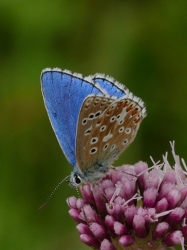 | 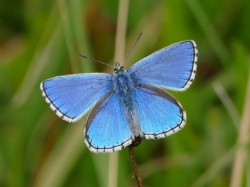 | 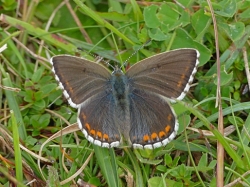 |
| Adonis Blue - Martin Down Photo © Mark Wagstaff | Adonis Blue - Martin Down Photo © Mark Wagstaff | Adonis Blue -Martin Down Photo © Mark Wagstaff |
Old Winchester Hill. More photos of the Silver- Spotted Skipper mating ritual [Posted by Ashley Whitlock]
Old Winchester Hill. In not ideal conditions a blanket of cloud over most of the Meon Valley today but it was quite warm on the main southern slope of Old Winchester Hill today, and it did threaten to become somewhat sunnier although this didn't last, however the butterfly count was very good considering. The Silver-Spotted Skipper was buzzing about with great gusto (little whizzers!). I managed to count up to 15 (on the fort slope) and I suspect there were far more as I saw at least 3 together. Two managed to court each other, although they never mated not in my presence anyway! I've seen many butterfly mating rituals but I think the Silver-Spotted Skipper is one of the best. One male was in pursuit of this rather lovely female, she was very stand off-ish, he had seen one male off, and kept in pursuit of this female, as she flew off he was off in hot pursuit. When he lost interest trying to bend his abdomen round to hers, she just moved away. He then just flew off close by and started feeding on a Small Scabious. When she flew off again he was in hot pursuit. I watched this fascinating maneuvering for at least 10 minutes. Other butterflies of interest were good numbers of immaculate Adonis Blues, (14) males and at least (2) females. Chalk Hill Blues were still in evidence but looking rather tatty now, with the odd ones still looking in good shape. Common Blues look as if they may well have had another brood as they were in good number and shape as well. I counted (14) species today despite the conditions. [Posted by Ashley Whitlock]
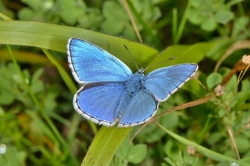 | 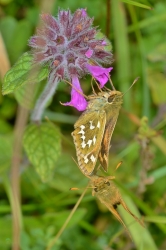 | 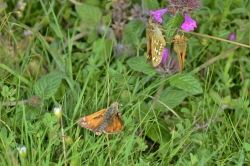 |
| Male Adonis Blue Photo © Ashley Whitlock | Male in pursuit of the female Silver-Spotted Skipper Photo © Ashley Whitlock | Another male comes into the close incounter Photo © Ashley Whitlock |
Chalton Down, Clouded Yellow Again. After a visit to Portsdown Hill, I revisited Chalton Down (SU736156), where I had seen and photographed a Clouded Yellow on 17th August. Today, where the temperature reached 19 degrees, Chalk Hill Blues and Meadow Browns were in good numbers, with a few worn Gatekeepers, fresh Small Heaths and Whites. Only a single Brimstone, a female was seen. Once I reached the top of the slope so a Clouded Yellow made an appearance, presumably the same individual I saw a few days ago.
Totals: Brimstone 1F, Large White 2, Small White 6, Clouded Yellow 1, Chalk Hill Blue 35M 7F, Common Blue 1M, Gatekeeper 4, Meadow Brown 28, Small Heath 8. [Posted by Roy Symonds]
Portsdown Hill (East). Today I visited the Eastern end of Portsdown Hill where the temperature was 17 degrees. Meadow Browns and Large Whites were most common with a few worn Gatekeepers. A few odd Chalk Hill Blues were seen among the Common Blues.
Totals: Large White 7, Small White 4, Chalk Hill Blue 2M, Common Blue 5M, Gatekeeper 2, Meadow Brown 21, Small Heath 1, Speckled Wood 2. [Posted by Roy Symonds]
Chalton Down, Clouded Yellow. Today I visited Chalton Down, the temperature 21 degrees, where I was met almost immediately by a Clouded Yellow flying past me. I saw it later on the top of the slope where it stopped to feed and I was able to get several photos. Elsewhere Chalk Hill Blues and Meadow Browns were flying in good numbers. No Brimstones were seen but several Large Whites, no doubt some migrants increasing numbers, while the Gatekeepers seem to have almost finished.
Totals: Large White 14, Small White 3, Clouded Yellow 1, Chalk Hill Blue 52M 1F, Common Blue 5M, Gatekeeper 3, Meadow Brown 23, Small Heath 5. [Posted by Roy Symonds]
Old Winchester Hill. At last - an Adonis Blue at OWH! A lovely day to be out and there are still masses of Chalk Hill Blues at OWH making it quite a spectacle. In addition I managed 4 Adonis Blues at the bottom of the car park slope (just as the track turns left). Very active and not settling much. Never ceases to amaze me how in the first instance I can frequently mistake a Common Blue for an Adonis Blue but when I see the real thing the colour is just amazing. For what it's worth I think these were originating from the short sward to the left of the track but then making their way over to the longer grass (and flowers) on the right hand side. Also a lot of Clouded Yellow about in the same area this morning - difficult to be accurate as it's easy to double count but I think somewhere in the region of 6/7 even being a little conservative. Like the Adonis Blues - they were not hanging around much to be photographed! [Posted by Mark Wagstaff]
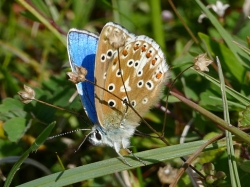 | 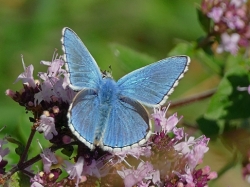 | 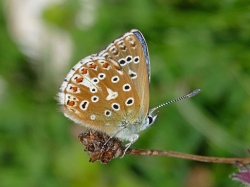 |
| Adonis Blue - Old Winchester Hill Photo © Mark Wagstaff | Adonis Blue - Old Winchester Hill Photo © Mark Wagstaff | Adonis Blue - Old Winchester Hill Photo © Mark Wagstaff |
Brimstone bonanza, Ropley area. Dr David Martill, University of Portsmouth, reports 'hordes' of Brimstones seen along the Watercress Line in the vicinity of Ropley, many nectaring on Buddleja. [Posted by Andrew Brookes]
Holly Blue in a Gosport Garden. How satisfying to seed-plant Lantana camara (Ham & Eggs plant) and find it in use by our tiny winged friends! A passing female Holly Blue found the many flowers quite to its liking and allowed me to get a shot or two.
(Incidentally, sudden illness since early May has totally curtailed my outings this year and all my (few) summer species captured on camera have been visitors to my back garden. Hopefully normal service will be resumed next year) [Posted by Francis Plowman]
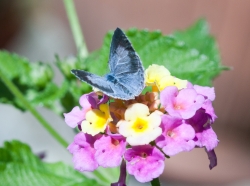 | 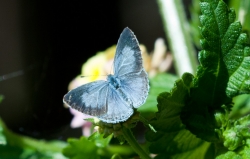 |
| Photo © Francis Plowman | Photo © Francis Plowman |
Clifden Nonpareil in Leigh Park, Havant. Clifden Nonpareil in my moth trap at Leigh Park this morning was a nice surprise. [Posted by Barry Collins]
Oxenbourne Down. After visiting Old Winchester Hill, I called at Oxenbourne Down on the way home to look for Silver-spotted Skippers. Here the temperature was 20.5 degrees with many Chalk Hill Blues flying. I did managed to find 3 Silver-spotted Skippers and got a few photos.
Totals: Chalk Hill Blue 80M 5F, Gatekeeper 4, Meadow Brown 24, Small Heath 7, Small Skipper 1, Silver-spotted Skipper 3. [Posted by Roy Symonds]
Old Winchester Hill Clouded Yellows. Today I spent a total of 3 hours walking Old Winchester Hill where the temperature was 20 degrees. Meadow Browns and Chalk Hill Blues were in good numbers as well as fresh Brimstones. A total of 14 different species were seen, although no Silver-spotted Skippers. A real bonus was seeing a total of 3 Clouded Yellows. The first was seen on the main path forking left as you leave the main car park, while two were seen while I descended the steps from the hill fort area down the side of the wooded hillside where the pair were seen flying along the slope.
Totals: Brimstone 11M 9F, Clouded Yellow 3, Large White 2, Small White 3, Chalk Hill Blue 85M 4F, Common Blue 16M 2F, Gatekeeper 4, Meadow Brown 101, Small Heath 1, Painted Lady 3, Red Admiral 1, Silver-washed Fritillary 1, Small Tortoiseshell 2, Small Skipper 1. [Posted by Roy Symonds]
Browndown N. A fair No of Graylings out on the central heathland today including a courting couple
The Male showing off his upper wings , a rare sight.
Chris Cobb [Posted by Chris Cobb]
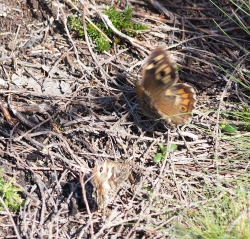 |
| A Courting Couple Photo © Chris Cobb |
Dingy Skipper, Stockbridge Down. A couple of photos of a Dingy Skipper seen on Stockbridge Down mid morning. [Posted by Michael Duffy]
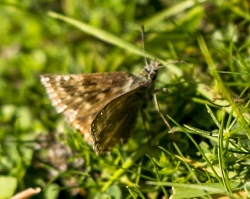 | 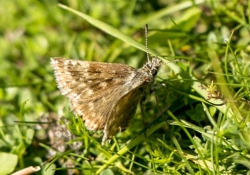 |
| Photo © Michael Duffy | Photo © Michael Duffy |
Portsdown Hill and Paulsgrove Chalk Pits. Today with the weather windy and cloudy but with some sunny spells, I visited the Eastern end of Portsdown Hill (SU657063) where Meadow Browns and some Chalk Hill Blues were seen. Numbers were low due to the sun frequently disappearing.
Totals: Large White 1, Meadow Brown 19, Speckled Wood 1, Chalk Hill Blue 7M, Common Blue 1M, Holly Blue 1.
Next I went to the Western end of Portsdown Hill to Paulsgrove Chalk Pits (SU6306) where Meadow Browns, Whites and Chalk Hill Blues were the commonest species seen. After halfway during a circular walk there, once again the sun disappeared frustratingly.
Totals: Brimstone 1M, Large White 4, Small White 3, Gatekeeper 2, Meadow Brown 17, Small Heath 2, Speckled Wood 1, Chalk Hill Blue 11M 1F. [Posted by Roy Symonds]
Noar Hill Revisited. After visiting Noar Hill yesterday and having seen the Brown Hairstreak, I was keen to return once more to try my luck again. Today the temperature was warmer and more species were on the wing a total of 14. I saw just a single female Brown Hairstreak ovapositing in the same area as yesterday, the Triangle where I was able to get another photo. Brimstones, Meadow Browns and Common Blues were the next most numerous species seen along with Silver-washed Fritillarys in the wooded areas.
Totals: Brimstone 5M 5F, Large White 3, Small White 1, Brown Hairstreak 1, Common Blue 21M 3F, Gatekeeper 8, Meadow Brown 16, Small Heath 9, Speckled Wood 7, Comma 1, Painted Lady 1, Peacock 3, Red Admiral 7, Silver-washed Fritillary 8. [Posted by Roy Symonds]
Martin Down (again). A morning visit from 0900-1330 before the weather collapsed again produced Clouded Yellow 1, Brown Argus 8, Common Blue 15, Chalk Hill Blue 6, Painted Lady 1, Dark Green Fritillary 3 (very worn!), Comma 1, Large White 2, Dingy Skipper 2 (2nd brood), Small Skipper 1, Small Tortoiseshell 5, Meadow Brown 12, Gatekeeper 10, and a tired looking Hummingbird Hawkmoth on one of the chalk tracks. Had a scout around for Silver Spotted Skippers but no luck. [Posted by Mark Pike]
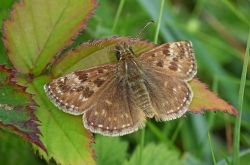 | 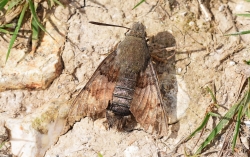 | 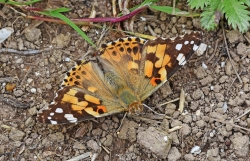 |
| Photo © Mark Pike | Photo © Mark Pike | Photo © Mark Pike |
Adonis and Clouded Yellow at St Catherines Hill. A couple of fresh male Adonis Blue and a single Clouded Yellow were the star attractions at St Catherine's Hill this morning; the supporting cast including many Chalk Hill Blue and Meadow Brown and various numbers of Small White, Brimstone, Small Copper (one only), Brown Argus, Common Blue and Small Heath. Disappointingly, no Silver-spotted Skipper and strangely not a single Gatekeeper, which are still active in my garden. [Posted by Rupert Broadway]
Silver Spotted Skippers at Oxenbourne Down. A short trip 9:30 - 10:45 covering just the lower, short grassy slopes. At least 6 Silver-spotted Skippers (all males). Also 50 + Chalk Hill Blues and a few Small Heaths amongst other common species. [Posted by Keith Turner]
Noar Hill. Today I visited Noar Hill (SU7431) to search for the Brown Hairstreak, a species frustratingly I did not see last year despite several visits to this site. My visit lasted just over 4 hours, during which time I walked most areas searching the trees and scrub. It was not until towards the end of my visit that some fellow enthusiasts I had met with before showed me the area where they had seen a male earlier. No luck there but at the Triangle a female appeared and landed on a Blackthorn bush where it crawled underneath a leaf and ovaposited. After I manged a photo it quickly flew off fast in an opposite direction. Looking up at the same bush I then spotted towards the top, a male at rest with wings wide open. So I was very pleased with my two sightings. Elsewhere a few Holly Blues were seen and well as Silver-washed Fritillarys in the woody areas, a two very worn Ringlets and two Painted Ladys.
Totals: Large White 4, Small White 3, Brown Hairstreak 2, Common Blue 15M 1F, Holly Blue 4, Gatekeeper 10, Meadow Brown 15, Ringlet 2, Small Heath 6, Painted Lady 2, Red Admiral 2, Silver Washed Fritillary 8. [Posted by Roy Symonds]
Martin Down. More from Martin Down [Posted by Mark Wagstaff]
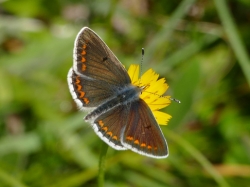 | 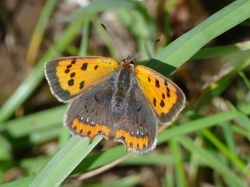 | 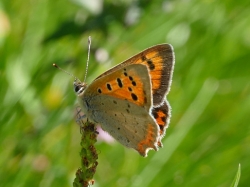 |
| Brown Argus - Martin Down Photo © Mark Wagstaff | Small Copper - Martin Down Photo © Mark Wagstaff | Small Copper - Martin Down Photo © Mark Wagstaff |
Martin Down. Today looked like it was going to be the best of a (very!) poor week so I decided on the long trip to Martin Down. I was hoping it would be my last of the year to this site if I managed to see Adonis Blue - the fact that I'm planning another will tell you how successful I was - none found (although perhaps a little early?). Certainly the sun shone but it was surprisingly cold and quite breezy. All that said there were lots to see - Chalk Hill Blues by the ditch, lots of Common Blues everywhere, Brown Argus, fresh Brimstones and fresh Small Tortoiseshell. Also some obliging Small Coppers and even some faded Dark Green Fritillaries about (5). So, a wonderful day even though the main attraction stayed away. Good excuse to go again! [Posted by Mark Wagstaff]
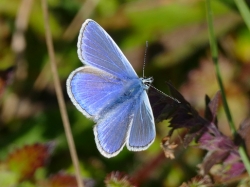 | 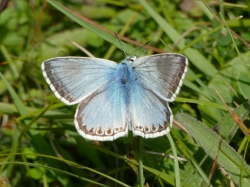 | 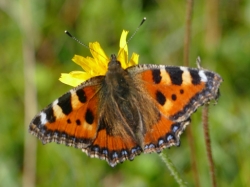 |
| Common Blue - Martin Down Photo © Mark Wagstaff | Chalkhill Blue - Martin Down Photo © Mark Wagstaff | Small Tortoiseshell - Martin Down Photo © Mark Wagstaff |
Oxenbourne Down. After visiting Charlton Down, I travelled to nearby Oxenbourne Down (SU7118). Here the weather was still warm, but with very high humidity and where low cloud could be see. Numbers of butterflies wrere therefore not as high as usual, but still a good number of Chalk Hill Blues were flying.
Totals: Chalk Hill Blue 65M 1F, Holly Blue 1, Gatekeeper 9, Meadow Brown 6 and Small Heath 2. [Posted by Roy Symonds]
Charlton Down. Today I visited Charlton Down (SU736156) where despite some overcast conditions, the temperature was 17 degrees, with many butterflies on the wing with 13 species recorded. Chalk Hill Blues and Meadow Browns were the most common. A few fresh Brown Argus were seen as well as a very strong and fast flying Dark Green Fritillary. Gatekeeper numbers seemed to have dropped significantly here now, as well as Small Skippers of which only a single specimen was seen.
Totals: Brimstone 1F, Large White 5, Small White 4, Green-veined White 1, Brown Argus 3, Chalk Hill Blue 51M 5F, Common Blue 9M, Gatekeeper 9, Meadow Brown 24, Small Heath 4, Dark Green Fritillary 1, Peacock 1, Small Skipper 1. [Posted by Roy Symonds]
Adonis at Broughton. Fresh Adonis Blue seen at Broughton Down yesterday at the western end of the reserve at the top of the driveway. [Posted by Mike Allen]
Immature Stages. Some photos that I hope are of interest - a Silver-washed Fritillary 1st instar larva, taken in Pamber Forest; the larva has created a silk pad among the moss, on which I saw the egg laid, and on which it will overwinter. Also, Silver-spotted Skipper are doing well at Broughton Down, and I managed to get a photo of an egg today before the inevitable rain! [Posted by Peter Eeles]
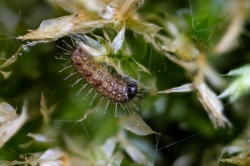 | 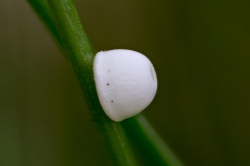 |
| 1st instar Silver-washed Fritillary larva Photo © Peter Eeles | Silver-spotted Skipper egg Photo © Peter Eeles |
Northington Down. A hummingbird hawkmoth is zooming around our buddleia on a dull Monday morning - easily evading a Red Admiral who seems to be claiming territorial rights to this bush.
How a solitary hawkmoth seeks and finds our buddleia out here in the backwoods seems an extraordinary achievement. [Posted by Robert Bryant]
South Hayling and beyond. Despite the butterflies being in short supply (on Ashley's field trip to South Hayling), we did manage to unearth a few interesting moths. A nationally scarce Bordered Grey was flushed from a scrubby area of Gorse; three Red Underwings were found roosting on the sunny side of a building (see Ashley's post), and; two Sulphur Pearl (Sitochroa palealis) micro moths were found at the tip of the Kench. I also popped into South Browndown on the way home and found some Small Ranunculus larvae feeding on Prickly Lettuce. [Posted by Dave Pearson]
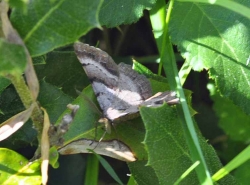 | 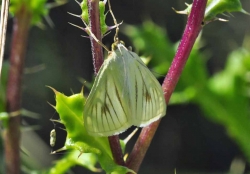 | 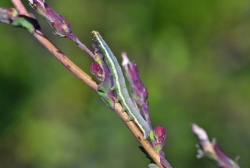 |
| Bordered Grey (male) Photo © Dave Pearson | Sulphur Pearl (Sitochroa palealis) Photo © Dave Pearson | Small Ranunculus larvae Photo © Dave Pearson |
Hayling Island Field Trip. A perfect day today, but the absence of the Purple Hairstreak in the scrubby Oaks looks as if we were a few weeks late. We wandered around some of the areas where I had seen the Grayling butterfly in the past but after a couple of hours of fruitless searching we headed back to the car-park with a few butterflies for our efforts,11 species, in the areas of shingle, gorse, and scrubby meadows cut into the gorse, butterflies of interest were Small Copper, Small Heath, Holly Blue, Common Blue, Brown Argus, and I managed to see a male Jersey Tiger moth while waiting for everybody to turn up. A female Red Admiral was seen testing spindly nettles with her forefeet whilst laying eggs. In the afternoon I decided to look around the bird sanctuary known as the 'The Ketch' and by an old abandoned building right by the side of the road opposite the golf course we encountered some Red Underwings sheltering from the daylight, and low and behold in the brilliant sunshine just above our heads a Grayling parked itself settling with its wings at an angle towards the sun, typical Grayling behavior! He took off over towards the Ketch area, but I suspect it came from the Golf Course, as I used to see them there a few years ago. Still it was a target species, and I thank everybody who made the trip onto Hayling Island, which isn't easy, with all the traffic. [Posted by Ashley Whitlock]
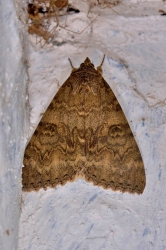 | 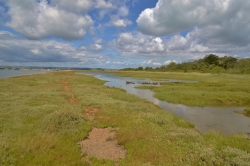 | 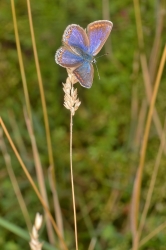 |
| A Red Underwing Moth Photo © Ashley Whitlock | The Ketch bird santucary, an area where I've seen Grayling in the past Photo © Ashley Whitlock | Female Common Blue Photo © Ashley Whitlock |
Ranvilles Lane and Newlands Farm, Fareham. A walk around my patch primarily to look for migrant birds produced a good selection of butterflies as well. The highlight was a Purple Hairstreak which landed nearby giving me some great views and allowing for a photo to be taken.
Totals: Green-veined White 8, Small White c80, Purple Hairstreak 1, Small Copper 1, Common Blue 12, Holly Blue 2, Red Admiral 8, Small Tortoiseshell 1, Painted Lady 2, Comma 4, Speckled Wood 10, Gatekeeper 15, Meadow Brown 20. Also 2 Silver Y, 3 golden-ringed Dragonflies, 2 Southern Hawkers and 2 Migrant Hawkers. [Posted by Mark Rolfe]
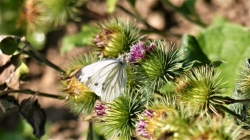 | 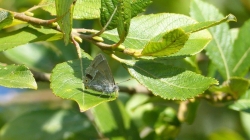 | 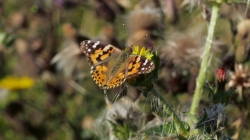 |
| Green-veined White Photo © Mark Rolfe | Purple Hairstreak Photo © Mark Rolfe | Painted Lady Photo © Mark Rolfe |
Old Winchester Hill. Paid another visit to OWH today. The weather was fine and sunny and the wind at least reduced from recent days to just a breeze. For anyone wishing to see Chalk Hill Blues en masse then now is a good time - the bottom of the car park slope (it would be the bottom!) is alive with them and most in very good condition. I searched this area for Adonis Blues but no luck - perhaps just a little early for the second generation if they are going to appear here? In addition to the usual suspects we did manage my first Clouded Yellow of the year - again at the bottom of the car park slope. Plenty to see on the west side of the fort too if your knees are as dodgy as mine! [Posted by Mark Wagstaff]
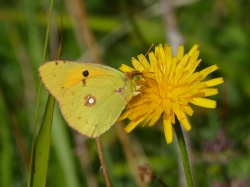 |
| Clouded Yellow - Old Winchester Hill Photo © Mark Wagstaff |
More from Broughton Down. more photographs [Posted by Chris Rose]
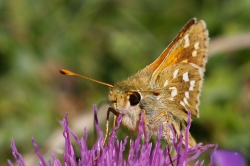 | 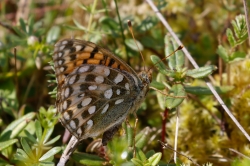 | 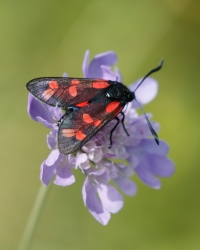 |
| Silver-spotted Skipper Photo © Chris Rose | Dark-green Fritillary Photo © Chris Rose | Six-spot Burnet Photo © Chris Rose |
Broughton Down. After leaving Shipton Bellinger in torrential rain, I arrived at Broughton Down as the sunshine returned. Coming out of the woodland there were many Brimstones and six-spot Burnets about, but it wasn't until I reached the far end of the reserve that I found the first Chalk Hill Blues. There were not that many on the wing, I only counted 5 individuals. There were also 2 Silver-spotted Skippers, and 2 very faded Dark-green Fritillaries. Walking down the slope there were more Silver-spotted Skippers about, I counted at least a dozen, and also 7 Dark-green Fritillaries. Coming back up the slope towards the woodland i was lucky to have pointed out to me a Silver-washed "valenzina" fritillary nectaring on valerian, the perfect end to a good day out.
https://awayfromfourmarks.blogspot.co.uk/ [Posted by Chris Rose]
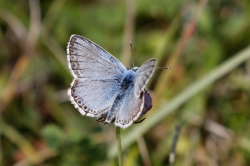 | 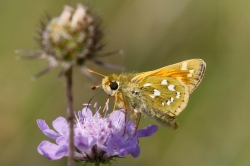 | 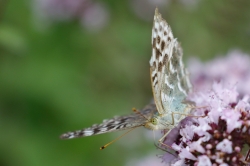 |
| Chalkhill Blue Photo © Chris Rose | Silver-spotted Skipper Photo © Chris Rose | Silver-washed fritillary Photo © Chris Rose |
More From Shipton Bellinger. More photographs
https://awayfromfourmarks.blogspot.co.uk/ [Posted by Chris Rose]
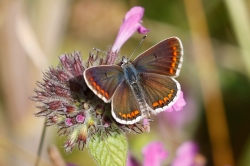 | 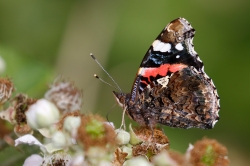 | 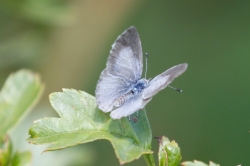 |
| Brown Argus Photo © Chris Rose | Red Admiral Photo © Chris Rose | Holly Blue Photo © Chris Rose |
Shipton Bellinger. My first visit here in the hope of finding Brown Hairstreaks, and early start with rain wasn't too promising but by 9.30 the sun was out and along the trees on the county border there were several Red Admirals, a Brown Argus, up to 6 Holly Blues, and of course many Meadow Browns. I found the first Brown Hairstreak at 9.50, a female and it gave some excellent views. Over the course of the next hour hairstreaks could be seen higher up in the trees. Finally around 11.00 a male came down, and then when considerably more people arrived a female performed admirably, even in the rain. Other butterflies seen were 2 Silver-washed Fritillaries, a Small Copper, several Common Blues, 3 Commas and 4 female Brimstones. https://awayfromfourmarks.blogspot.co.uk/ [Posted by Chris Rose]
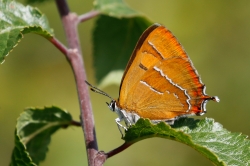 |  | 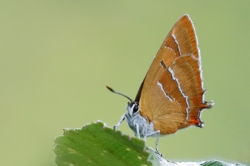 |
| Brown Hairstreak Photo © Chris Rose | Brown Hairstreak Photo © Chris Rose | Brown Hairstreak Photo © Chris Rose |
Big Butterfly Count. I carried out several counts for the BBC today and along with the exoected species I saw a Clouded Yellow in Farlington and Small Tortoiseshell and Painted Lady in Hayling Island - all nice surprises [Posted by Mark Tutton]
Shipton Bellinger Field Trip. More photographs from the field trip [Posted by Ashley Whitlock]
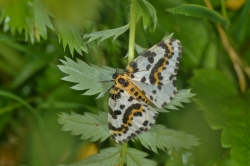 | 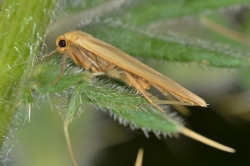 | 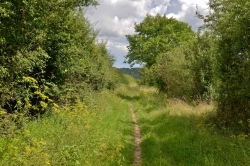 |
| Magpie moth Photo © Ashley Whitlock | Common Footman Photo © Ashley Whitlock | Typical habitat for the Brown Hairstreak Photo © Ashley Whitlock |
Shipton Bellinger Field Trip. Another field trip threatened with large areas of dark grey clouds, however we were lucky especially in the morning when the rain held off and we had good bouts of warm sunshine which brought out our quarry the Brown Hairstreak. Walking along one of the known footpaths we saw up to three males having a battle in a small area where there was good Blackthorn thickets and some moderately sized Ash trees. We had already espied a lovely female with its wings open almost at ground level, but unfortunately all of us never saw this splendid specimen. We had a rather wounded male which had obviously been caught by a bird and had a big chunk out of its wings. Close-by there was also a rather fetching female down at camera height which seemed to be glued to the leaf it was perched on and became a rather fetching superstar. There is definitely more activity when the sun shone after a period of cloudy rain sodden looking skies, and in all we counted about a dozen Brown hairstreak in total. Other stars were a lovely Magpie moth which seemed to be stunned by the weather, as we saw it in a period between bouts of sunshine and was quite tame. Other species of note were Brown Argus, Small Heath, Silver-washed Fritillary, and the usual suspects. I like to thank all who came on the field trip and made a most enjoyable experience. [Posted by Ashley Whitlock]
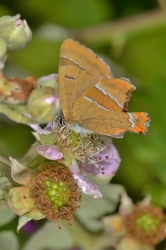 | 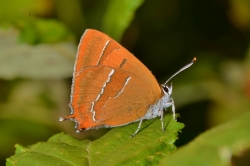 | 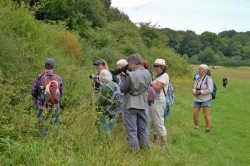 |
| Male with rather a large bird strike Photo © Ashley Whitlock | Superstar female Photo © Ashley Whitlock | Looking for that illusive Hairstreak Photo © Ashley Whitlock |
Oxenbourne Down. After returning home from visiting my son and his wife in Cornwall, I visited Oxenbourne Down (SU7118) where the temperature was 20 degrees. I was searching for the Silver-spotted Skipper. I managed to find a total of 3 in among the hundreds of Chalk Hill Blues that were flying on the slopes. Fresh Small Heaths were flying and a couple of Brown Argus.
Totals: Large White 1, Brown Argus 2, Chalk Hill Blue >200, Common Blue 3, Gatekeeper 12, Meadow Brown 23, Small Heath 7, Peacock 1, Silver Spotted Skipper 3. [Posted by Roy Symonds]
Obliging Female Brown Hairstreak At Noar Hill. Lady luck was definitely on my side this morning at Noar Hill, as I unusually chose to access the reserve by the Charity Farm route. Just minutes after entering, I spotted my main target - a female Brown Hairstreak feeding contentedly on Hemp Agrimony close to the stone circle. Had I eventually reached the spot after first exploring the other side of the reserve, as I normally do, I may have missed her amongst the mass of flower heads, or been too late. She stayed for around 20 minutes within the same small area, in blustery, mainly cloudy conditions, before making a 10 yard flight over the bank. Try as I might I could not relocate her, so suspect she was en route into nearby trees. A few sunny intervals produced some brief open wing views. [Posted by Alan Thornbury]
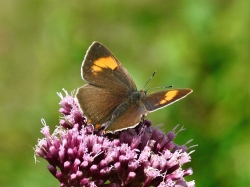 | 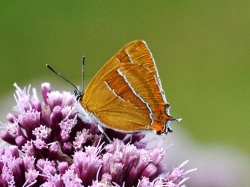 | 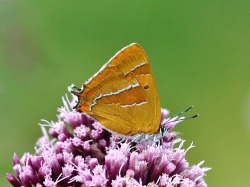 |
| Brown Hairstreak Photo © Alan Thornbury | Brown Hairstreak Photo © Alan Thornbury | Brown Hairstreak Photo © Alan Thornbury |
Noar Hill. I decided at the last minute on a trip to Noar Hill today - in the hope of seeing Brown Hairstreaks. Its the first time I've been to the reserve at this time of year - its my 'go to' place for Duke of Burgundy early in the year but I've not returned later. On previous visits I hadn't noticed the amount of blackthorn here - there is a lot! So, not knowing any 'hot spots' I worked my way up one side of the reserve and down the other peering into every likely blackthorn/ash area I could find. After nearly 2 hours (and no hairstreaks) my neck was telling me enough - so I reluctantly decided to call it a day. Not that I'd had a bad day - far from it with the carpet of wild flowers worth the trip alone, then add in lots of Common Blues, Brown Argus, Green-veined White and Painted Lady and it was a lovely morning - but just a tinge of disappointment I hadn't found what I principally came for. On the way out I decided to look in the bottom chalk pit for one last effort and met the same enthusiast who had found a female Brown Hairstreak at Shipton Bellinger just a few days before. You can probably guess what happened next - she amazingly found another! Hidden away high up in a bramble - there is no way I would have found it. Fortunately it descended - presumably to egg lay - and posed nicely. A wonderful end to the visit and I will be eternally grateful to Hazel for making my day! [Posted by Mark Wagstaff]
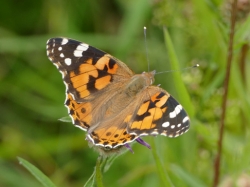 | 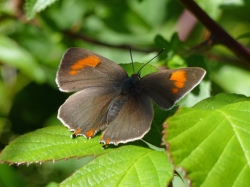 | 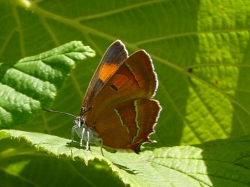 |
| Painted Lady - Noar Hill Photo © Mark Wagstaff | Brown Hairstreak - Noar Hill Photo © Mark Wagstaff | Brown Hairstreak - Noar Hill Photo © Mark Wagstaff |
White Admiral survey. Today I conducted my first survey for White Admiral larvae in Pamber Forest and found 16 in just over an hour, together with 7 absentees (based on the typical larval feeding damage and "pier"; I assume predated). Based on previous years, this is a pretty good "hit rate" and it would appear, based on this limited data, that White Admiral has had a relatively-good year. Most larvae are in their 2nd instar, with some still in their 1st instar. None are in their 3rd instar, so I don't hold out much hope for a second brood; the recent weather seems to have calmed things down considerably. I also found a final instar larva (I assume that overwintered in 2016/2017) that has been parasitised, presumably by Cotesia sibyllarum - the usual culprit when it comes to White Admiral. Amazingly, this larva is still feeding as per normal, despite grubs having emerged from it, where they have built cocoons, pupated, and then emerged. [Posted by Peter Eeles]
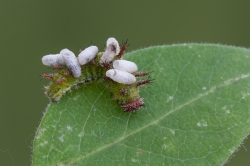 |
| Photo © Peter Eeles |
Charlton Down. A look in on Charlton Down which is about a mile away from Oxenbourne Down as the crow flies, had many Chalkhill and Common Blues today, in fact it was festooned with them! Other excellent counts came of Small White and Large White, maybe a small influx from across the channel. There were several species I saw here though not noted at Oxenbourne Down, these were Dark-green Fritillary(4), Brown Argus, Small Tortoiseshell, Peacock and Comma. Other species of note were Small Copper, and Small Heath. [Posted by Ashley Whitlock]
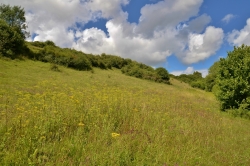 | 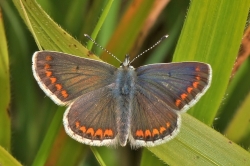 | 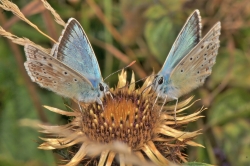 |
| Charlton Down Photo © Ashley Whitlock | Brown Argus Photo © Ashley Whitlock | Chalkhill Blue double take! Photo © Ashley Whitlock |
Oxenbourne Down. A look up at Oxenbourne Down today in very windy conditions and the temperature was struggling as well, and it took a while to get my eye in on the Silver-Spotted Skipper today. However after an hour or so the count was into double figures with several females being the tamest of the two sexes, and I found one female, which stayed on a stemless thistle for about five minutes and allowed me to look at her quite closely. Other species of note were good numbers of Chalk Hill Blues, and the Small Heath is building up its numbers. Small Copper, numbers on site are disappointing, I hope they get better throughout the month of August or we have a good Autumn and we get a third brood. I also saw a couple of Silver-washed Fritillaries, one of these a male was in excellent condition. Others of note good numbers of Common Blue and the Gatekeeper is now past its peak. Barry Collins who I met up there also saw a Clouded Yellow but I never saw this. [Posted by Ashley Whitlock]
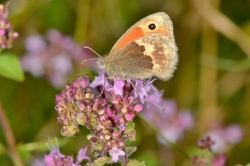 | 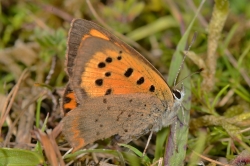 | 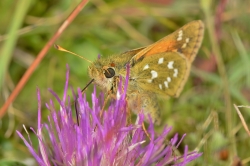 |
| Small Heath Photo © Ashley Whitlock | Female Small Copper Photo © Ashley Whitlock | Female Silver-Spotted Skipper Photo © Ashley Whitlock |